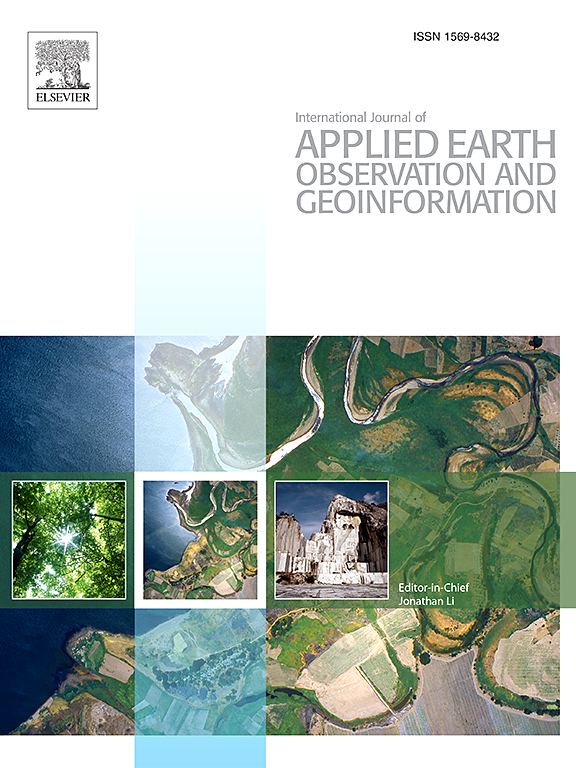Exploring the optimal method for quantifying the contribution of driving factors of urban floods
IF 7.6
Q1 REMOTE SENSING
International journal of applied earth observation and geoinformation : ITC journal
Pub Date : 2025-05-14
DOI:10.1016/j.jag.2025.104597
引用次数: 0
Abstract
Amid climate change and urban expansion, urban floods (UFs) have become a significant concern. Effective UF management requires two key elements: (1) assessing susceptibility to identify flood-prone hotspots and (2) analyzing factor contributions to pinpoint primary drivers. While research on urban flood susceptibility (UFS) is well-established, studies on factor contributions usually limited to the simple application without fully evaluating their alignment with UF characteristics. This study addresses this gap by examining Shenzhen, a rapidly urbanizing city, and applying various regression methods (linear, multiple machine learning (ML), and Shapley Additive exPlanations (SHAP)) to evaluate flood-driving factors. Through accuracy assessments and environmental considerations, we identify the most suitable methods for this analysis. Our findings include: (1) Random Forest (RF)-based UFS assessment reveals significant spatial heterogeneity, with higher UFS in central-western areas and lower risks in the southeast; (2) the most contributing factors in Shenzhen exhibit non-linear and non-parametric effects on UF, supporting the use of RF; (3) we found substantial spatial heterogeneity in factor contributions, necessitating SHAP analysis to capture local variations and provide tailored management insights. Thus, this study integrates methodological rigor with urban environmental context, enhancing factor contribution analysis for UF and supporting effective management strategies.
探索城市洪水驱动因子贡献量化的最佳方法
在气候变化和城市扩张的背景下,城市洪水(UFs)已成为人们关注的焦点。有效的UF管理需要两个关键要素:(1)评估易感性以识别洪水易发热点;(2)分析因子贡献以确定主要驱动因素。虽然对城市洪水易感性(UFS)的研究已经很成熟,但对因子贡献的研究通常局限于简单的应用,没有充分评估其与城市洪水易感性特征的一致性。本研究通过考察深圳这个快速城市化的城市,并应用各种回归方法(线性、多元机器学习(ML)和Shapley加性解释(SHAP))来评估洪水驱动因素,从而解决了这一差距。通过准确性评估和环境考虑,我们确定了最适合此分析的方法。结果表明:(1)基于随机森林(Random Forest, RF)的UFS评估显示出显著的空间异质性,中西部地区UFS较高,东南部风险较低;(2)深圳市对用友影响最大的因子表现为非线性和非参数效应,支持射频的使用;(3)各因素的贡献存在显著的空间异质性,因此有必要利用SHAP分析来捕捉地方差异,并提供有针对性的管理见解。因此,本研究将方法的严密性与城市环境背景相结合,加强UF的因素贡献分析,并支持有效的管理策略。
本文章由计算机程序翻译,如有差异,请以英文原文为准。
求助全文
约1分钟内获得全文
求助全文
来源期刊

International journal of applied earth observation and geoinformation : ITC journal
Global and Planetary Change, Management, Monitoring, Policy and Law, Earth-Surface Processes, Computers in Earth Sciences
CiteScore
12.00
自引率
0.00%
发文量
0
审稿时长
77 days
期刊介绍:
The International Journal of Applied Earth Observation and Geoinformation publishes original papers that utilize earth observation data for natural resource and environmental inventory and management. These data primarily originate from remote sensing platforms, including satellites and aircraft, supplemented by surface and subsurface measurements. Addressing natural resources such as forests, agricultural land, soils, and water, as well as environmental concerns like biodiversity, land degradation, and hazards, the journal explores conceptual and data-driven approaches. It covers geoinformation themes like capturing, databasing, visualization, interpretation, data quality, and spatial uncertainty.
 求助内容:
求助内容: 应助结果提醒方式:
应助结果提醒方式:


